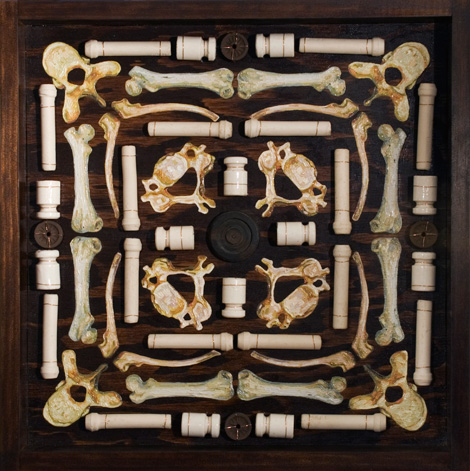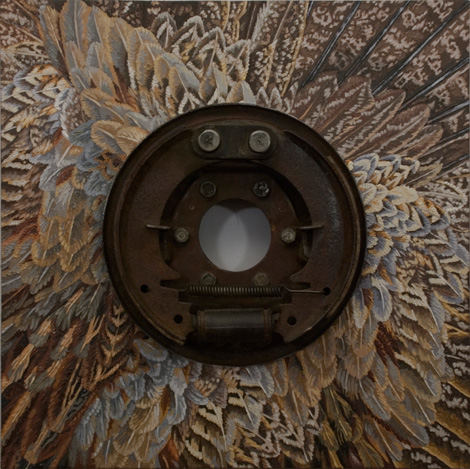California artist Alyson Souza creates paintings and sculptures that draw parallels between man-made relics—vintage electrical equipment, say, or battered geographer’s tools—and nature forms of similar shape, texture, or function. An immense head of cabbage opens to reveal a topographical map in its circular core, the raised veins of the leaves echoing the drawn lines of the drafted elevations (Neutral Ground, all works 2014). Small bones echo electrical conduits, forcing the comparison between the bodily processes and energy flow (Nonconductive). A steel disc from an old car, like a tufted avian neck, is ringed by a collar of feathers (Break Down). A miniature portrayal of an Italianate landscape rests in a dark circle at the back of a skull (Site Specific), rather like memories occupying the mind.
In the center of Souza’s exhibition is a large structure, a simple wooden house (The Speed of Dark). The red electrical lines running to the roof suggest veins or arteries. The door of the house is painted and sculpted like a ribcage, hinting at a link between a domestic interior and the chest cavity. The intercostal spaces open to reveal verdant trees (bones?) and a cloudy sky (breath? sighs?). They invade the defined domestic space to expose the usual inside/outside boundaries as both relative and permeable.
Souza’s house recalls the “Cells” series of Louise Bourgeois: sculptural enclosures that similarly combine salvaged architectural materials, found objects and fabricated elements. But whereas Bourgeois insisted that her surreal rooms were autobiographical (to be read as Freudian analyses of the father-daughter relationship), Souza’s house deconstructs a trope that reaches farther back in history.
Souza’s work countermands the binary metaphysics of Western culture dating back to Aristotle that position man as separate from nature. The Ancient Greeks built heavy fortified walls to establish physical barriers between the city and the outlying wilderness. But Souza’s walls (i.e., her boundaries/frames/painted contours) intermingle realms. This aspect of her work recalls the ideas of French sociologist Bruno Latour, who argued for the non-polarized view of nature as culture. Latour reminds us that scientific “facts” about the natural world are social constructs.
Latour further insists that the question is not “Is it real or is it constructed?” but “Is it constructed well enough to become an autonomous fact?” In reference to art, one might reconfigure Latour’s second question as, “Is it constructed well enough to carry the meaning?” As it happens, Alyson Souza paints beautifully, piling rich impastos over confident lines to create luscious surfaces that invite careful viewing. The adamant physicality of her painted surfaces insists on contemplation. Viewers cannot slide by them, as if slipping across plastic, with rushed, only partial consideration. There is a sense of discovery and delight in quietly exploring these artworks. They’re attractive, interesting, and expertly crafted. In a society addicted to the fast—and therefore shallow—appraisal (the “hit”), objects redolent of hand-made intimacy stop us, slow our pace, and draw us (as seers) closer (to the seen).



